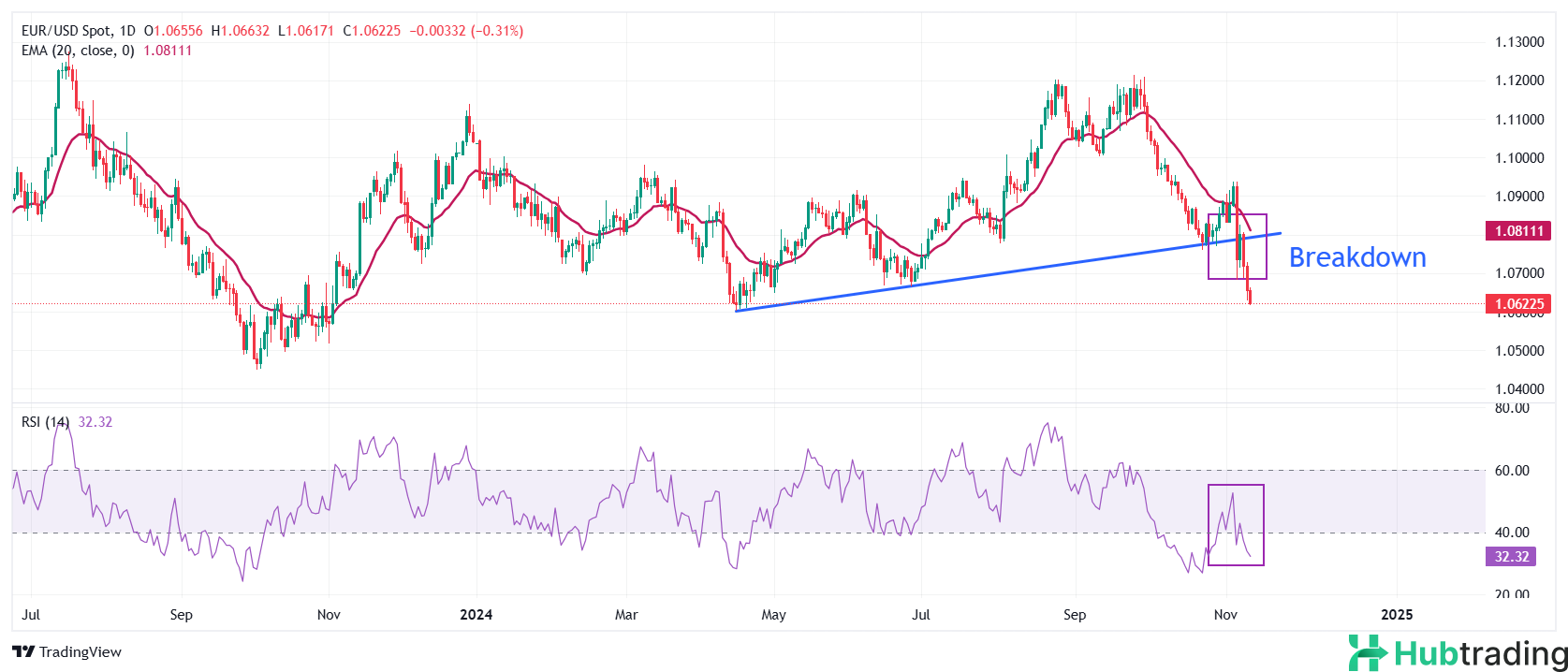- EUR/USD drops toward 1.0600 as investors anticipate that Trump’s protectionist policies will heavily impact the Eurozone’s export sector.
- The European Central Bank (ECB) is expected to reduce interest rates by 50 basis points in December.
- Market attention shifts to the upcoming US inflation data for October.
EUR/USD hits a fresh nearly seven-month low, dipping below 1.0620 during Tuesday’s European session. The pair remains under heavy selling pressure as concerns mount over the Eurozone’s export outlook, fueled by President-elect Donald Trump’s campaign promise to impose a 10% tariff on imports.
Market analysts believe Trump’s landslide victory is likely to boost consumer confidence and business sentiment in the US, but raises significant concerns for key trading partners like the Eurozone. His protectionist stance, including the potential for a global trade war, is particularly troubling. Trump has suggested that the Eurozone will “pay a big price” for not purchasing enough US exports, exacerbating fears of escalating trade tensions.
According to a recent paper from the London School of Economics, a 10% tariff on all imported goods, as advocated by Trump, could reduce the EU's GDP by 0.1%.
Political uncertainty in Germany is also contributing to the Euro's decline. Last week, Chancellor Olaf Scholz dismissed Finance Minister Christian Lindner, triggering the collapse of Germany’s three-party coalition government. Scholz is considering calling a no-confidence vote in December, potentially leading to a snap election in early 2025, according to Deutsche Welle.
This political instability, combined with potential weakness in German exports, puts additional pressure on the European Central Bank (ECB) to act. ING analysts note that a full recovery in Germany’s fiscal position seems unlikely, and the ECB is expected to bear the burden of supporting the Eurozone economy. The bank is anticipated to cut interest rates by 50 basis points in December to counter these challenges.
EUR/USD Weakens as US Dollar Strengthens
- EUR/USD is also being weighed down by the ongoing strength of the US Dollar. The Greenback continues to benefit from what are being called "Trump trades," with the US Dollar Index (DXY) rising above 105.70. Optimism about the potential impact of Trump’s policies, including increased labor demand, higher business investment, and sustained inflationary pressures, is boosting the USD.
- The US Federal Reserve is expected to maintain a more gradual pace of policy easing, with analysts at JP Morgan raising their terminal rate forecast to 3.5%, up from 3%.
- According to the CME FedWatch tool, there is a 65% chance the Fed will reduce interest rates by 25 basis points to 4.25%-4.50% in December.
- Investors will closely monitor the US Consumer Price Index (CPI) data for October, due for release on Wednesday, along with comments from several Fed officials, including Chairman Jerome Powell.
- Economists expect headline inflation to accelerate to 2.6% in October, up from 2.4% in September, with core CPI expected to rise steadily to 3.3%.
Technical Analysis: EUR/USD Continues to Slide
EUR/USD extends its decline for a third consecutive day on Tuesday, approaching the year-to-date (YTD) low near 1.0600. The pair is showing signs of further downside, with the 20-day Exponential Moving Average (EMA) turning sharply lower near 1.0800, signaling continued bearish momentum.
The 14-day Relative Strength Index (RSI) has moved into the 20.00-40.00 range, indicating growing downward momentum and reinforcing the bearish outlook.
On the downside, EUR/USD could test the psychological support level of 1.0500 if it breaks below 1.0600. On the upside, resistance at the round number of 1.0700 will likely act as a key barrier for any potential Euro rallies.






